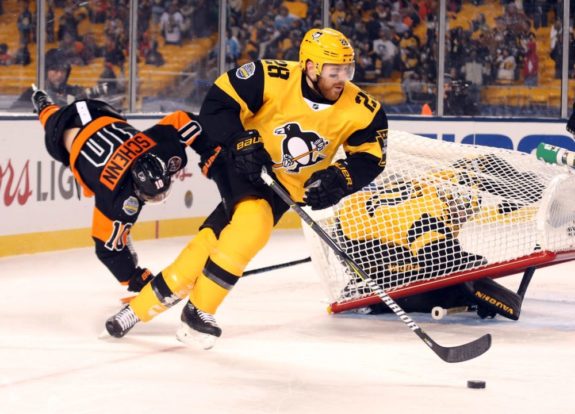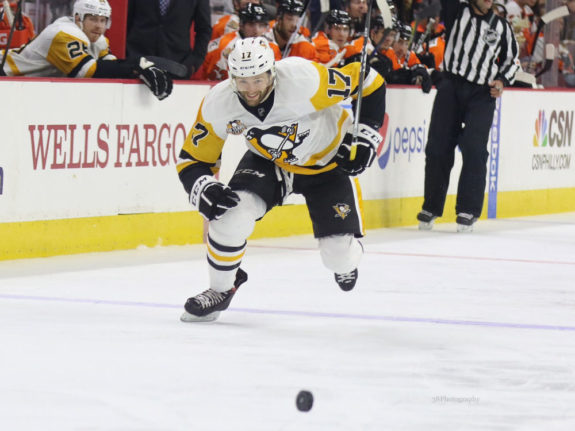When a player positions himself along the boards, it can mask the immediate threat this player poses. The Penguins thrive on this misapprehension. For them, the boards provide a refuge, an accelerant, and a laboratory. Danger is modulated until the puck is whipped cross-ice, or floated from behind the net to the low slot and stashed in the back of the net.
The Penguins’ breakouts make a very daunting assignment look easy. They do not exit the zone on every first attempt, but their composure and awareness of how to proceed in the face of adversity are traits that make coach Mike Sullivan’s Penguins special.
Penguins Flip the Script
The Penguins don’t panic when hemmed in. In that instance where an opposing first forechecker succeeds in disrupting the retrieval, the opposing F3 practically bounces into the lower half of the offensive zone.
At first, the Penguins try the obvious methods: they move the puck up the boards or middle of the ice, and if that fails, they chuck it out and try to create a race. If the opponent gets several shot attempts and is zipping the puck around the Penguins’ defensive zone, a Pittsburgh defenseman will grab possession and direct it toward the corner boards. And in that lost corner, the Penguins will overload, and likely exit the puck from the zone with adequate puck support.

While the corner boards are seen as problematic for many teams and defensemen— a precarious black hole where zone exits are swallowed—the Penguins seize upon them as a sanctuary. They can outnumber their enemy with bodies, slow the pace of the puck in their defensive zone, and give those outside the corner time to protect the passing and shooting lanes.
The perimeter of the neutral zone is another way the Penguins devour ice and gain position. Their defensemen and forwards are adept at slinging the puck at angles where opponents can be caught off balance and flustered, giving their linemates advantageous position.
Take this set play against the Capitals in last year’s playoffs, for instance:
On a reset in their own zone, Justin Schultz passes it to Ian Cole, who spots Scott Wilson hiding along the boards in the neutral zone. The quick movement of the puck allows Wilson to hit Nick Bonino in stride as he enters the offensive zone, and they convert on a breakaway. In many ways, this play is an aberration because the Cole-to-Wilson stretch pass is achieved over such a long distance. But the play still demonstrates the larger point.
The Penguins understand the basic math of hockey: five players on the opposing team invariably leave some parts of a 200 x 85 rink unoccupied. Most teams protect the middle and push out from there, which is why the Penguins make the boards their friend, a useful tool to use against their adversary. The stretch pass, a cross-ice pass, an indirect pass to create a race, or having a man stationed at the boards as a slick middle-man who takes the puck to direct toward his teammates rocketing up the ice —these are all the methods that become available. The puck travels faster than the player, and the area around the boards is malleable.
Penguins Use the Outside to Move Inside
When the Penguins are in the offensive zone, the wolf is at the door. Their opponent is in peril, but because the Penguins’ forwards are outside of the slot, the opponent may believe they’ve neutralized them. But the Penguins thrive on this presumption. They fire pucks from the boards at the net and hope an unknotted defense cannot corral the rebound.
Out of the goaltender’s sightline, they engineer offense from below the goal line with cutting forwards slipping into space and ripping off pucks with a quick release. The rancorous forecheck work from a Bryan Rust or Patric Hornqvist leads to more blunt methods, like trying to jam the puck in at off-angles.

Like all of Sullivan’s instruction, this is very smart. In their own zone, the Penguins rely on puck support to squash any hope the opponent has once the puck gets directed towards the corners. If the Penguins have time to react, they can and will eliminate the shooting or passing lane. The only hope for the opponent is to move the puck toward open space quicker than the Pens can react, and sometimes Pittsburgh can leave areas around the slot vulnerable due to their aggression along the boards.
In the neutral zone, the Penguins use the space around the boards to exploit their speed advantage. They want races to the puck; they want their forwards moving at full speed in a chase after the puck or in possession of the puck. This forces the defense into uncomfortable contortions in the transition game.
In the offensive zone, it is about getting the puck toward the net before the goalie can react. Sometimes this is with one-timers; other times it is with quick cross-ice passes. But the space below the goal line enables the forward to work behind the net with the goaltender’s vision somewhat obscured. Along the half-wall, there are several options to choose from and angles that can be exploited. The Penguins appreciate the carom and use it shrewdly in all three zones.
The Penguins want to play faster than their opponents, and conversely, they want to slow pace to a crawl if their opponent gains a foothold in their own zone. The boards are their instrument to achieve that, and they harness them in a way that no one else in today’s game quite manages to do.